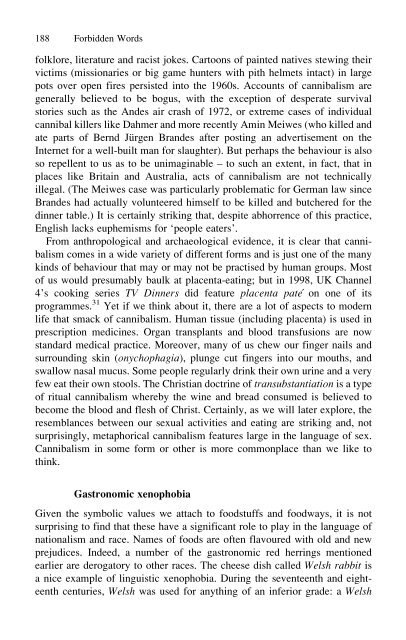Forbidden Words: Taboo and the Censoring of Language
Forbidden Words: Taboo and the Censoring of Language
Forbidden Words: Taboo and the Censoring of Language
Create successful ePaper yourself
Turn your PDF publications into a flip-book with our unique Google optimized e-Paper software.
188 <strong>Forbidden</strong> <strong>Words</strong><br />
folklore, literature <strong>and</strong> racist jokes. Cartoons <strong>of</strong> painted natives stewing <strong>the</strong>ir<br />
victims (missionaries or big game hunters with pith helmets intact) in large<br />
pots over open fires persisted into <strong>the</strong> 1960s. Accounts <strong>of</strong> cannibalism are<br />
generally believed to be bogus, with <strong>the</strong> exception <strong>of</strong> desperate survival<br />
stories such as <strong>the</strong> Andes air crash <strong>of</strong> 1972, or extreme cases <strong>of</strong> individual<br />
cannibal killers like Dahmer <strong>and</strong> more recently Amin Meiwes (who killed <strong>and</strong><br />
ate parts <strong>of</strong> Bernd Jürgen Br<strong>and</strong>es after posting an advertisement on <strong>the</strong><br />
Internet for a well-built man for slaughter). But perhaps <strong>the</strong> behaviour is also<br />
so repellent to us as to be unimaginable – to such an extent, in fact, that in<br />
places like Britain <strong>and</strong> Australia, acts <strong>of</strong> cannibalism are not technically<br />
illegal. (The Meiwes case was particularly problematic for German law since<br />
Br<strong>and</strong>es had actually volunteered himself to be killed <strong>and</strong> butchered for <strong>the</strong><br />
dinner table.) It is certainly striking that, despite abhorrence <strong>of</strong> this practice,<br />
English lacks euphemisms for ‘people eaters’.<br />
From anthropological <strong>and</strong> archaeological evidence, it is clear that cannibalism<br />
comes in a wide variety <strong>of</strong> different forms <strong>and</strong> is just one <strong>of</strong> <strong>the</strong> many<br />
kinds <strong>of</strong> behaviour that may or may not be practised by human groups. Most<br />
<strong>of</strong> us would presumably baulk at placenta-eating; but in 1998, UK Channel<br />
4’s cooking series TV Dinners did feature placenta paté on one <strong>of</strong> its<br />
programmes. 31 Yet if we think about it, <strong>the</strong>re are a lot <strong>of</strong> aspects to modern<br />
life that smack <strong>of</strong> cannibalism. Human tissue (including placenta) is used in<br />
prescription medicines. Organ transplants <strong>and</strong> blood transfusions are now<br />
st<strong>and</strong>ard medical practice. Moreover, many <strong>of</strong> us chew our finger nails <strong>and</strong><br />
surrounding skin (onychophagia), plunge cut fingers into our mouths, <strong>and</strong><br />
swallow nasal mucus. Some people regularly drink <strong>the</strong>ir own urine <strong>and</strong> a very<br />
few eat <strong>the</strong>ir own stools. The Christian doctrine <strong>of</strong> transubstantiation is a type<br />
<strong>of</strong> ritual cannibalism whereby <strong>the</strong> wine <strong>and</strong> bread consumed is believed to<br />
become <strong>the</strong> blood <strong>and</strong> flesh <strong>of</strong> Christ. Certainly, as we will later explore, <strong>the</strong><br />
resemblances between our sexual activities <strong>and</strong> eating are striking <strong>and</strong>, not<br />
surprisingly, metaphorical cannibalism features large in <strong>the</strong> language <strong>of</strong> sex.<br />
Cannibalism in some form or o<strong>the</strong>r is more commonplace than we like to<br />
think.<br />
Gastronomic xenophobia<br />
Given <strong>the</strong> symbolic values we attach to foodstuffs <strong>and</strong> foodways, it is not<br />
surprising to find that <strong>the</strong>se have a significant role to play in <strong>the</strong> language <strong>of</strong><br />
nationalism <strong>and</strong> race. Names <strong>of</strong> foods are <strong>of</strong>ten flavoured with old <strong>and</strong> new<br />
prejudices. Indeed, a number <strong>of</strong> <strong>the</strong> gastronomic red herrings mentioned<br />
earlier are derogatory to o<strong>the</strong>r races. The cheese dish called Welsh rabbit is<br />
a nice example <strong>of</strong> linguistic xenophobia. During <strong>the</strong> seventeenth <strong>and</strong> eighteenth<br />
centuries, Welsh was used for anything <strong>of</strong> an inferior grade: a Welsh

















